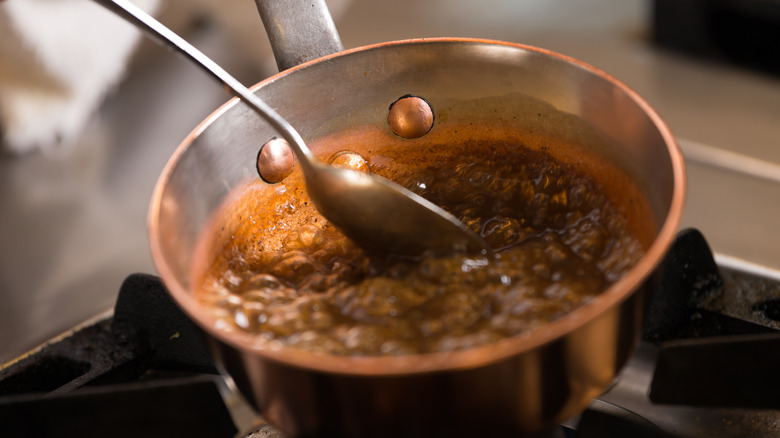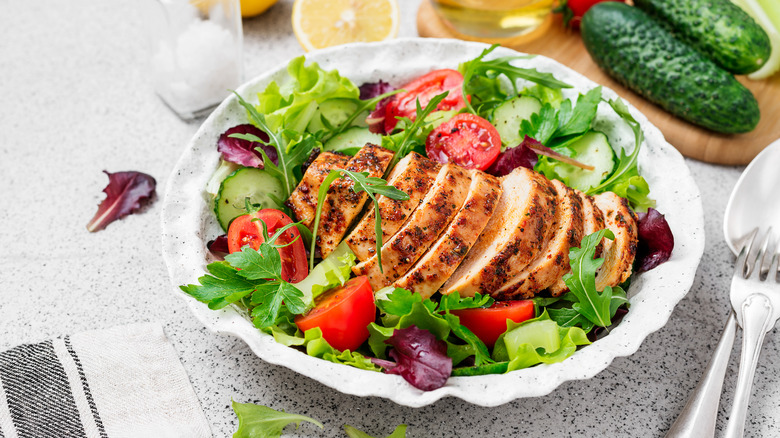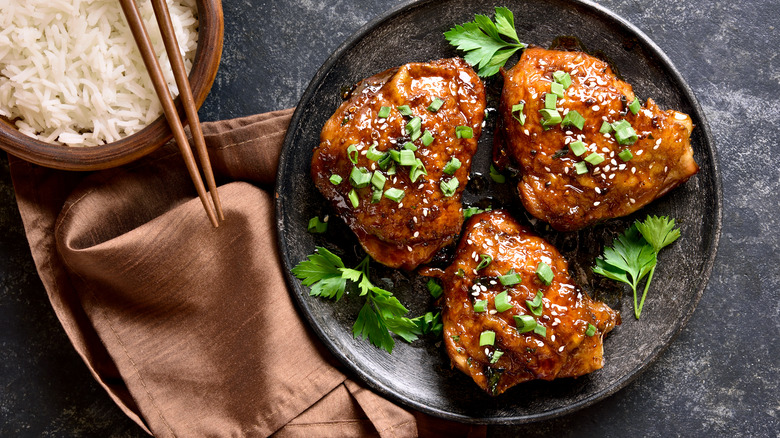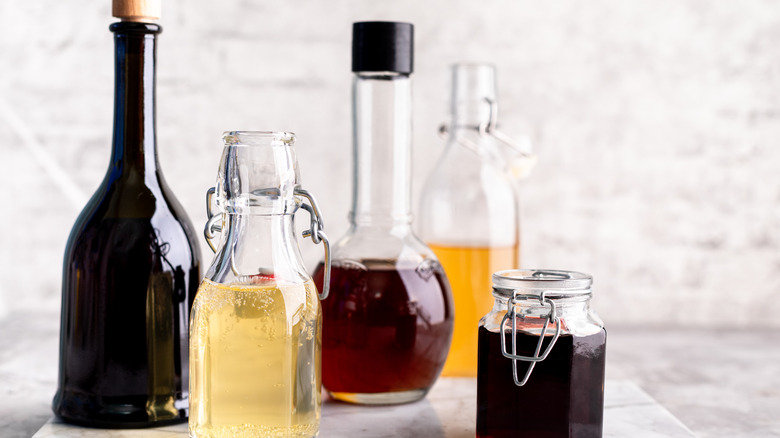What Is Kitchen Bouquet And Why Do People Use It?
You may have seen a recipe that included Kitchen Bouquet along with the list of ingredients; and finding your pantry bare of it, tried to approximate its contributions without knowing exactly what they were. According to its manufacturer Hidden Valley Kitchens, Kitchen Bouquet is a concentrated broth distilled from a combination of vegetables and seasonings that "adds enhanced color and savory flavor" to a variety of dishes. And per Cook's Info, it's a prepared bottled sauce used during the cooking process, rather than afterward like a table condiment.
It's generically known as a gravy browner or browning sauce, and while Cook's Info contends that some feel Kitchen Bouquet has a taste reminiscent of beef, Taste of Home says gravy browner lends smoky and molasses notes. BBC includes cakes and icing among the inventory of foods it might be used in. To confuse matters, Jamaican Browning Sauce functions similarly, yet is made only with brown sugar, salt, and water. The point of the sauce is to elevate the complexity and color of meals so they appear to have been long-simmered, marinated, and seared when they might have only had a hasty heat-through or quick blitz in the microwave. Or it's simply to give our cooking a boost; Kitchen Bouquet's official brand site says it's the answer to great turkey gravy. First sold over 140 years ago (via Cook's Info), modern cooks, often challenged to find time in the kitchen, reach for it as a shortcut to all-day flavor.
More about Kitchen Bouquet
Surprisingly, Kitchen Bouquet was developed by a candy maker according to The Clorox Company, (parent company of the Hidden Valley brand). In 1882, while testing various caramels, he blended a mixture of vegetable juices and spices with a caramel base, creating the same bottled sauce sold today. Home cooking has changed a lot since its debut, and the product's marketing reflected the shifts. In the 1920s, Kitchen Bouquet was promoted for its convenience and ability to upgrade a fast dinner. During the 50s the focus changed to the economy it offered by way of improving inexpensive cuts of meat and preserving the size of meat cooked at lower temperatures. It appeared in later ads next to a microwave and a roast, improbably browned. Thanks to its prolonged production, Kitchen Bouquet is still available and contends to do all of the above, plus darken, thicken, and season gravy, stews, and soups per Cannibal Kitchen; additionally, the blog notes it's vegan and gluten-free.
Kitchen Bouquet currently rates 4.5 out of 5 stars among Amazon customers, with reviewers commenting, " ... I won't make gravy without it." and, " ... perfect addition for browning Cajun food e.g. gumbo, jambalaya." Many noted that it's been difficult to find at their local grocery. A 4-ounce bottle costs $2.73 at Walmart.com.
Kitchen Bouquet adds appetizing color
Per Cook's Info, gravy browner can be added before cooking to perk up the color and mimic the look of lightly charred and roasted food. By the same token, it's an appetizing fix for a meal that either hasn't had the time or the technique to develop natural browning like slow-cooker dishes or microwaved meat, for example; for this purpose, brush it on after cooking but before serving according to Taste of Home. In fact, Kitchen Bouquet's main ingredient is caramel color, and per Kitchn, some food stylists rely on it to contribute that particular golden-browned and sticky/saucy appearance that makes savory foods look mouth-watering in professional photographs.
Not just marketed as an improvement for roasted foods, in the product description Hidden Valley Kitchens claims that Kitchen Bouquet imparts " ... rich color to soups, stews, sauces and gravies," while food blog Recipe Marker says it's used as a thickening agent in the previous dishes. In addition, it gives baked goods a golden hue; albeit some claim it tastes mildly of beef, so it may be more suited to a savory recipe like bacon cheddar biscuits or crackers.
The sauce seasons too
Kitchen Bouquet is not all about appearances, however; according to The Clorox Company, an application to roasts creates a seal that keeps juices from escaping during cooking. Further, per their site, add it to enhance the taste of soups, stews, chili, and vegetarian dishes. Via Midwest Living, it can be incorporated as a seasoning in burger patties, meatloaf mix, or a schnapps and apple juice pan-sauce reduction poured over pork tenderloin. Can't Stay Out of the Kitchen features a gluten-free recipe for Smothered Salisbury Steak where Kitchen Bouquet is a component of the savory mushroom onion gravy along with Worcestershire sauce and beef stock. And finally, according to Recipe Marker, it can be added to a marinade. Taste of Home recommends a light hand with the amount of Kitchen Bouquet added to a dish, as too much can lend an acrid taste.
The ingredients include caramel color, onion, carrots, celery, cabbage, parsnips, turnips, parsley, salt, spices, and sodium benzoate (a man-made preservative that lengthens the shelf-life of processed foodstuffs, categorized as Generally Recognized as Safe [GRAS] by the FDA via Healthline and Recipe Marker). Per American Restaurant, although similar to another store-bought gravy browner, they find the flavor and quality of ingredients in Kitchen Bouquet to be superior; additionally, comparable products might contain soy, MSG, or wheat.
How to substitute the ingredient
According to Taste of Home, if you're trying to avoid specific ingredients or additives that are present in Kitchen Bouquet or another prepared browning sauce, you can make your own enriching and browning agent with cane sugar, water, and salt. Sugar is gently heated until fully dissolved, then cooked and stirred constantly until it's a deep brown. Water is slowly incorporated into the syrup and lastly, salt is added. The finished sauce should be stored in an air-tight bottle in the refrigerator, where it will keep for up to six months. A version shared by Back to Basics Gal has a much longer ingredient list and includes brown sugar, butter, assorted vegetables, flour, and lemon juice. This option seems closer to Kitchen Bouquet's savory profile and relies on the natural sweetness of the vegetables for the integral sugar or caramel element.
For those times that call for a quick stand-in, there are common pantry substitutions such as Worcestershire sauce and dark molasses (via Cannibal Kitchen), and BBQ, soy, and Japanese teriyaki sauces per American Kitchen. (They note the distinction is important here, as Japanese teriyaki sauce contains rice wine, which gives it more depth and umami.)
While there are some days we can caramelize onions, extract every last flavor from a simmering stew, or roast a dish beautifully, there are others when we need a teaspoon or two of secret sauce.




